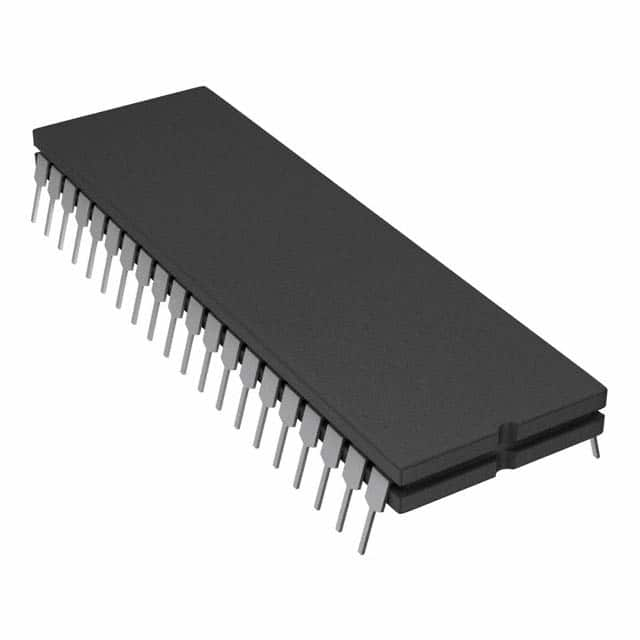Siehe Spezifikationen für Produktdetails.

HT83C51
Product Overview
Category
HT83C51 belongs to the category of microcontrollers.
Use
It is primarily used for embedded systems and various applications that require control and processing capabilities.
Characteristics
- HT83C51 is a high-performance microcontroller with an 8-bit architecture.
- It operates at a clock frequency of up to 12 MHz.
- The microcontroller offers a wide range of integrated peripherals, including timers, UART, I2C, and ADC.
- It supports both serial and parallel communication interfaces.
- HT83C51 has a low power consumption mode, making it suitable for battery-powered devices.
Package
The HT83C51 microcontroller is available in a variety of package options, such as DIP (Dual Inline Package) and PLCC (Plastic Leaded Chip Carrier).
Essence
The essence of HT83C51 lies in its ability to provide efficient control and processing capabilities in embedded systems.
Packaging/Quantity
HT83C51 is typically packaged in tubes or trays, with quantities ranging from a few units to bulk orders.
Specifications
- Architecture: 8-bit
- Clock Frequency: Up to 12 MHz
- Program Memory Size: 4 KB
- Data Memory Size: 128 bytes
- Number of I/O Pins: 32
- Operating Voltage: 2.7V - 5.5V
- Operating Temperature Range: -40°C to +85°C
Detailed Pin Configuration
The HT83C51 microcontroller features a total of 40 pins, each serving a specific purpose. Here is a detailed pin configuration:
- VCC: Power supply voltage input
- GND: Ground reference
- P0.0 - P0.7: General-purpose I/O pins
- P1.0 - P1.7: General-purpose I/O pins
- P2.0 - P2.7: General-purpose I/O pins
- P3.0 - P3.7: General-purpose I/O pins
- RST: Reset pin for system initialization
- XTAL1: Crystal oscillator input
- XTAL2: Crystal oscillator output
- EA/VPP: External Access/Programming Enable
- ALE/PROG: Address Latch Enable/Program pulse
- PSEN: Program Store Enable
- RD: Read control signal
- WR: Write control signal
- T0: Timer 0 external input
- T1: Timer 1 external input
- INT0: External interrupt 0 input
- INT1: External interrupt 1 input
Functional Features
- HT83C51 offers a wide range of integrated peripherals, including timers, UART, I2C, and ADC.
- It supports both serial and parallel communication interfaces, allowing for versatile connectivity options.
- The microcontroller has a built-in watchdog timer for system reliability.
- It features multiple power-saving modes to optimize energy consumption.
- HT83C51 provides flexible interrupt handling capabilities for efficient event-driven programming.
Advantages and Disadvantages
Advantages
- High-performance microcontroller with an 8-bit architecture
- Wide range of integrated peripherals for enhanced functionality
- Low power consumption mode for battery-powered applications
- Versatile communication interfaces for connectivity options
- Flexible interrupt handling capabilities for efficient programming
Disadvantages
- Limited program memory size (4 KB)
- Limited data memory size (128 bytes)
- Relatively low clock frequency compared to some modern microcontrollers
Working Principles
HT83C51 operates based on the Von Neumann architecture, where program instructions and data are stored in separate memory spaces. The microcontroller fetches instructions from the program memory, executes them, and stores the results in the data memory. It follows a sequential execution model, where each instruction is executed one after another.
Detailed Application Field Plans
HT83C51 finds applications in various fields, including but not limited to: - Industrial automation - Home automation systems - Automotive electronics - Consumer electronics - Medical devices - Robotics
Detailed and Complete Alternative Models
Some alternative models to HT83C51 that offer similar functionalities include: - AT89C51 (Atmel) - PIC16F877A (Microchip) - MSP430G2553 (Texas Instruments) - STM8S103F3 (STMicroelectronics)
These alternative models provide comparable features and can be considered as substitutes for HT83C51 depending on specific requirements.
In conclusion, HT83C51 is an 8-bit microcontroller with versatile functionality and wide application possibilities. Its integrated peripherals, low power consumption, and flexible interrupt handling make it suitable for various embedded system designs.
Listen Sie 10 häufige Fragen und Antworten im Zusammenhang mit der Anwendung von HT83C51 in technischen Lösungen auf
Sure! Here are 10 common questions and answers related to the application of HT83C51 in technical solutions:
Q: What is HT83C51? A: HT83C51 is a microcontroller based on the 8051 architecture, commonly used in various technical solutions.
Q: What are the key features of HT83C51? A: HT83C51 features include an 8-bit CPU, on-chip RAM and ROM, multiple I/O ports, timers/counters, serial communication interface, and interrupt system.
Q: How can HT83C51 be used in technical solutions? A: HT83C51 can be used in various applications such as industrial automation, robotics, home automation, security systems, and embedded systems.
Q: What programming language is used for HT83C51? A: HT83C51 can be programmed using assembly language or high-level languages like C.
Q: How do I program HT83C51 microcontroller? A: To program HT83C51, you can use an Integrated Development Environment (IDE) like Keil uVision or SDCC, along with a suitable programmer.
Q: Can HT83C51 communicate with other devices? A: Yes, HT83C51 has built-in serial communication interfaces like UART, SPI, and I2C, which allow it to communicate with other devices.
Q: Can HT83C51 control motors or actuators? A: Yes, HT83C51 can control motors or actuators by utilizing its I/O ports and interfacing with motor driver circuits.
Q: Does HT83C51 support interrupts? A: Yes, HT83C51 supports both hardware and software interrupts, allowing it to respond to external events in real-time.
Q: Can HT83C51 be used for data acquisition and processing? A: Yes, HT83C51 can be used for data acquisition by interfacing with sensors and then process the acquired data using its computational capabilities.
Q: Is HT83C51 suitable for low-power applications? A: Yes, HT83C51 has power-saving features like idle mode and power-down mode, making it suitable for low-power applications.
Please note that these answers are general and may vary depending on the specific implementation and requirements of your technical solution.

